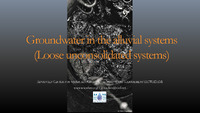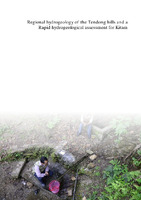Items
Tag
water management
-
 Groundwater in the alluvial systems Groundwater management in alluvial aquifer systems, particularly in regions like Neemrana, Rajasthan, presents challenges due to slow recharge and significant vulnerabilities. Effective water management strategies are essential, emphasizing the need for local governance to regulate groundwater use and implement best practices. In North Bihar, where 80% of water sources are groundwater-based, issues like drinking water scarcity and contamination during floods highlight the urgent need for improved sanitation and access to safe water. Reviving traditional water management systems and focusing on recharge structures near ridges can enhance groundwater sustainability in these areas.
Groundwater in the alluvial systems Groundwater management in alluvial aquifer systems, particularly in regions like Neemrana, Rajasthan, presents challenges due to slow recharge and significant vulnerabilities. Effective water management strategies are essential, emphasizing the need for local governance to regulate groundwater use and implement best practices. In North Bihar, where 80% of water sources are groundwater-based, issues like drinking water scarcity and contamination during floods highlight the urgent need for improved sanitation and access to safe water. Reviving traditional water management systems and focusing on recharge structures near ridges can enhance groundwater sustainability in these areas. -
 Weather The study of weather and climate is increasingly important due to climate change's impact on human life and agriculture, especially in India, where over 70% of the population relies on rain for farming. Understanding weather patterns is critical for effective watershed management and sustainable development, yet access to reliable weather data remains limited. The variability of rainfall across regions affects water resource planning, with significant changes in rainfall intensity observed in recent decades. Effective water management strategies, tailored to specific regional conditions, are essential to address issues such as water scarcity, erosion, and changing agricultural patterns.
Weather The study of weather and climate is increasingly important due to climate change's impact on human life and agriculture, especially in India, where over 70% of the population relies on rain for farming. Understanding weather patterns is critical for effective watershed management and sustainable development, yet access to reliable weather data remains limited. The variability of rainfall across regions affects water resource planning, with significant changes in rainfall intensity observed in recent decades. Effective water management strategies, tailored to specific regional conditions, are essential to address issues such as water scarcity, erosion, and changing agricultural patterns. -
 Regional hydrogeology of the Tendong Hills and a rapid hydrogeological assessment for Kitam The report discusses the complex hydrogeological dynamics of the Tendong Hills and Kitam area in Sikkim, highlighting the interplay of diverse rock types and structures that influence the region's aquifers and spring systems. It emphasizes the importance of incorporating geological insights into watershed and spring development programs to enhance water security, especially in light of climate change and human activities. ACWADAM is actively involved in developing hydrogeologically informed recharge strategies for springs in these areas, aiming to improve water management and community capacity building. The report also outlines specific recharge areas and spring characteristics, underscoring the need for careful monitoring and management to ensure sustainable water supply.
Regional hydrogeology of the Tendong Hills and a rapid hydrogeological assessment for Kitam The report discusses the complex hydrogeological dynamics of the Tendong Hills and Kitam area in Sikkim, highlighting the interplay of diverse rock types and structures that influence the region's aquifers and spring systems. It emphasizes the importance of incorporating geological insights into watershed and spring development programs to enhance water security, especially in light of climate change and human activities. ACWADAM is actively involved in developing hydrogeologically informed recharge strategies for springs in these areas, aiming to improve water management and community capacity building. The report also outlines specific recharge areas and spring characteristics, underscoring the need for careful monitoring and management to ensure sustainable water supply.